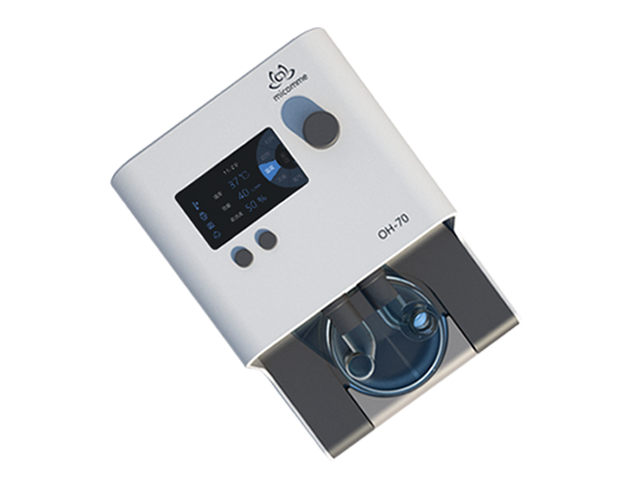High-flow nasal cannula oxygen therapy, HFNC is an oxygen therapy method that directly delivers a certain oxygen concentration of air-oxygen mixed with high-flow gas to the patient through a nasal catheter that does not need to be sealed. As a form of non-invasive respiratory support, it can quickly improve oxygenation. It can currently be used in patients with acute hypoxic respiratory failure, patients after surgery, patients with respiratory failure without tracheal intubation, patients with immunosuppression, and cardiac insufficiency. Patients etc. Foreign researchers have carried out many studies on the subject of nasal high-flow oxygen therapy, and its clinical value has been affirmed.
Features of High Flow Nasal Cannula Oxygen Therapy (HFNC)
1. Provide heated, humidified high flow oxygen flow.
HFNC can provide heated and humidified high-concentration oxygen through the nasal cannula, and the air flow can be as high as 60L/min. Because the air flow can be set to exceed the peak inspiratory flow level of most patients with respiratory failure, the oxygen concentration is guaranteed to be constant; The heating and humidifying functions of HFNC can protect the airway mucosa and enhance the cleaning ability of mucociliary. Reasonable airway humidification can dilute the secretions of the airway, keep the airway unobstructed and moist, maintain the normal function of the airway, and effectively prevent complications such as lung infection.
2. Increase functional residual capacity
Using electrical impedance tomography to evaluate the relationship between high-concentration nasal cannula oxygen inhalation, body position and end-expiratory volume. It is pointed out that no matter what posture is adopted, inhaling high-flow airflow through the nasal cannula can increase the overall regionality by increasing the functional residual volume. Lung impedance at the end of expiration.
Clinical application of high flow nasal cannula oxygen therapy (HFNC)
1. Used in patients with acute hypoxic respiratory failure
At the same PaCO2 level, patients receiving HFNC had a slower breathing rate, suggesting that lung dead space can be reduced. The increase in lung dead space can cause an increase in the mortality of patients with acute respiratory failure caused by hypoxemia and acute respiratory distress syndrome. The average tidal volume of the non-invasive ventilation group exceeded 9ml/kg body weight, and the degree of lung injury increased significantly, which resulted in a higher mortality rate than the high-flow oxygen therapy group.
2. Used for respiratory failure without tracheal intubation
The included patients were mainly pulmonary interstitial fibrosis, pneumonia, chronic obstructive pulmonary disease, cancer, hematological malignancies and congestive heart failure patients. The median treatment time of HFNC was 30 hours. The use of HFNC when patients with hypoxic respiratory distress refuse to have tracheal intubation can provide proper oxygenation and become another non-invasive ventilation method.
3. Applied to patients with cardiac insufficiency
International literature studies used HFNC in 10 patients with third-degree heart failure. Under the guidance of echocardiography, it was found that with the increase of output flow, the preload of the heart gradually decreased, and the respiratory rate also changed from 23% before the use of HFNC. Times/min decreased to 17 times/min and 13 times/min, which benefited patients with third-degree heart failure. After using HFNC, it was found that the use of traditional venturi masks in the stable period after non-invasive ventilation could not meet the patient's oxygenation needs. After using HFNC, the oxygenation was significantly improved and the degree of dyspnea was also significantly reduced.
4. It is applied to patients after tracheal intubation, tracheal intubation, and patients who need bronchoscopy
In a single-center study, the effect of HFNC on patients after tracheal intubation was compared with that of the venturi mask, which confirmed that PaO2/FiO2 in the HFNC group was higher, while the partial pressure of blood oxygen (PaO2) at 36h High, and fewer patients in the HFNC group require noninvasive positive pressure ventilation or endotracheal intubation. HFNC is used in the invasive operation of alveolar lavage, which can improve the safety of the operation. It has been reported that HFNC technology can also be used during tracheal intubation.
Conclusion
As a new oxygen therapy method, transnasal high-flow oxygen therapy (HFNC) can effectively improve oxygenation, reduce the probability of invasive and non-invasive mechanical ventilation, and use heating and humidifying devices to make the gas reach the most suitable temperature and humidity for the human body , Improve comfort, and have obvious advantages compared with traditional oxygen therapy. HFNC treatment has achieved some satisfactory results. With the wide application of HFNC, more options are provided for clinical oxygen therapy.
References:
Li Xia.Research progress of nasal high-flow oxygen therapy for respiratory support[J].Chinese Journal of Clinical Nursing,2017,9(03):271-274.
